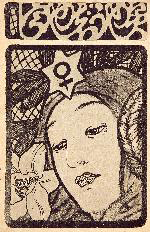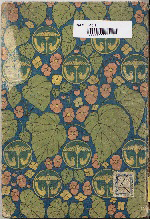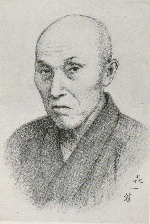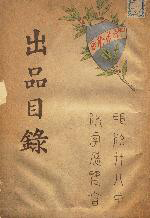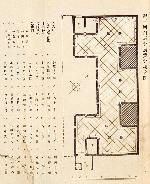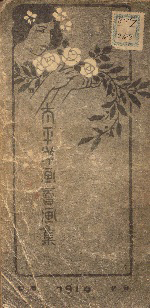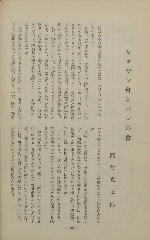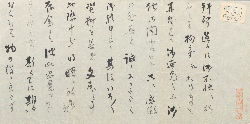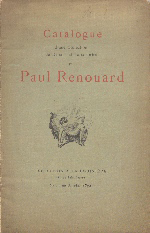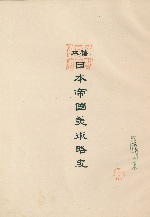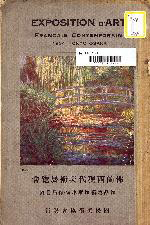![]()
Chapter 2: Art
Section 2: The influence of French art within Japan
From the end of the Meiji Era, works influence by France came to be seen in everyday situations thanks to the activities of FUJISHIMA Takeji (1867-1943), HASHIGUCHI Goyo (1880-1921) and other artists who worked on illustrations and bookbinding. Artworks brought over from France were exhibited as reference works at the exhibitions of various artists' groups, however with increasing interest in Western art, exhibitions were also held for the purpose of introducing French art, such as the Exhibition of French Contemporary Arts. Western art collectors also began to appear, including MATSUKATA Kojiro, OHARA Magosaburo (1880−1943), and FUKUSHIMA Shigetaro (1895-1960), and opportunities to appreciate French art were greatly expanded by the exhibitions of their collections. The magazine Shirakaba [雑8-49], which became a central presence in the Taisho Era literature world, also began to provide a large amount of coverage of French art. These increased opportunities to come into contact with French art, were significant in establishing the image of France, the "country of art".
The influence of French art seen in illustration
Myōjō (Dai1ji) 11 (1901.2.23), 2(4)(1902.4.1), Tokyo shinshisha [雑8-28] 
YOSANO Akiko, Midaregami, Tōkyō shinshisha, 1901 [特52-717] 
FUJISHIMA Takeji reproduced oil paintings and Hokusai Manga (lit. sketches by KATSUSHIKA Hokusai) from the time he was 3 years old. As he grew older, he studied traditional Japanese painting, however he could not throw away his dream of studying Western-style painting, and studied under SOYAMA Yukihiko (1860-1892) and YAMAMOTO Hosui (1850-1906). He joined the Hakubakai (lit. White Horse Society) when it was established in 1896, and was appointed an assistant professor at the Tokyo Fine Arts School after KURODA Seiki saw his talent, later being promoted to full professor. He also worked on illustrations and bookbinding, and was influenced by Art Nouveau and his covers for the magazine Myōjō and YOSANO Akiko's Midaregami became some of his leading works. He studied abroad in France and Italy in 1905. In 1925, he was awarded the Order of Academic Palms by the French Government.
IZUMI Kyōka, Aiaigasa, Hōmeisha, 1914 [特105-439] 
HASHIGUCHI Goyo studied traditional Japanese painting from the time he was in middle school, and studied western-style painting at the Hakubakai (lit. White Horse Society) Western-style Painting Research Institute and Tokyo Fine Arts School, and showed talent early on in the design, illustration and advertising art fields. He left behind a number of works which incorporated the Art Nouveau style and blended them with the Japanese world, including the Iwanami Shoten logo (used from the company's founding until 1933), and the illustrations for “Wagahai wa neko de aru” (the sequel) (contained in “Hototogisu” [Z13-233]). HASHIGUCHI's Kono Bijin (lit. A Beauty) won the contest offering a prize for an advertising image held by Mitsukoshi Gohukuten (Mitsukoshi Department Store) in 1911, and he won a prize of 1,000 yen, which was unprecedented for the time. In addition, he also worked on a large number of bookbinding jobs, and used techniques which are difficult to reproduce even today, such as applying Japanese lacquer to the cover artwork of works by NATSUME Soseki (1867-1916) and IZUMI Kyoka (1873-1939), producing works which were elaborate and of high artistic quality. The cover of this work is a colored block print on a dark blue background, and features a running pattern of flowers and shared umbrellas.
Artists' groupes
HIRAKI Masatsugu, Meiji shoki yōgadan kaiko, Nihon Ecching kenkyūjo shuppambu, 1936 [712-51] 
HIRAKI Masatsugu (1859-1943) travelled to Tokyo in 1873 and lived as a pupil in the home of GOSEDA Horyu I (1827-1892), who had invented his own unique semi-western painting style in the last days of the Tokugawa shogunate. He was recruited as a painter in 1880 for the Tokyo Education Museum, and worked as an assistant at the Imperial University of Science and Tokyo Higher Normal School thereafter. He joined the Meiji Bijutsukai (lit. Meiji Fine Arts Society) when it was formed in 1889, and after it broke up, he became affiliated with the Taiheiyogakai (lit. Pacific Painting Society). This work was serialized for 15 issues in the magazine Ecchingu from October 1934 to December of the following year, is written in mostly chronological order, and the content begins with HIRAKI's coming to Tokyo and ends with the Tokyo Artifact Fair in 1887. It shows the activities of the artists from before the popularization of Western-style painting.
Meiji bijutsukai (Ed.), Meiji bijutsukai tenrankai shuppin mokuroku, Meiji bijutsukai, 1892, 1895 [特67-789] 
In 1889, the Meiji Bijutsukai (lit. Meiji Fine Arts Society) was formed by ASAI Chu, KAWAMURA Kiyoo (1852-1934), GOSEDA Yoshimatsu (1855-1915), KOYAMA Shotaro (1857-1916), HARADA Naojiro (1863-1899), HONDA Kinkichiro (1851-1921), MATSUOKA Hisashi, and YAMAMOTO Hosui. The society opposed the movement for exclusion of Western-style painting which was becoming more intense against the background of ultranationalism, and there purpose was to promote the development of Western-style art. The society actively engaged in training and supporting the rising generation, however the rapid rise of the Hakubakai (lit. White Horse Society), headed by KURODA Seiki, resulted in the society gradually losing its leadership. This work is a catalog of exhibits from the 4th spring exhibition held in March 1892 and the 8th autumn exhibition held in October 1895.
MATSUZAKI Masabumi (Ed.), Yōga shinsai, Gahōsha, 1898 [79-235] 
The artists who left the Meiji Bijutsukai (lit. Meiji Fine Arts Society) due to dissatisfaction with its bureaucratic organization and dark artistic style formed the Hakubakai (lit. White Horse Society) in 1896, centering on KURODA Seiki and KUME Keiichiro. IWAMURA Toru, YAMAMOTO Hosui, FUJISHIMA Takeji, OKADA Saburosuke, WADA Eisaku, SHODAI Tameshige (1863-1951), KOBAYASHI Mango (1870-1947), NAGAHARA Kotaro (1864-1930) and GODA Kiyoshi (1862-1938) were involved in the founding of the society. The world saw the Hakubakai (lit. White Horse Society) and the Meiji Bijutsukai (lit. Meiji Fine Arts Society) as rivals and called the Hakubakai the Shinha (lit. new school) or Murasaki-ha (lit. Violet school) and the Meiji Bijutsukai the Kyuha (lit. old school) or Yani-ha (lit. Tar school). The Hakubakai (lit. White Horse Society) overwhelmed the Meiji Bijutsukai (lit. Meiji Fine Arts Society) and became the mainstream in painting circles, however it stopped its activities at its 13th exhibition in 1910 and broke up in March the following year. This work is a pictorial record of the 3rd Hakubakai Exhibition which was held in the no. 5 building of the Ueno Park exhibition from October to November of 1898.
ŌSHITA Tōjirō (Ed.) Taihei yōgakai gashū, Kōshōdō shuppambu, 1910 [327-263] 
After the breakup of the Meiji Bijutsukai (lit. Meiji Fine Arts Society), KAWAMURA Kiyoo, GOSEDA Horyu II (1864-1943), and ISHIKAWA Kin'ichi (1871-1945) formed the Tomoekai in 1902. Meanwhile, YOSHIDA Hiroshi (1876-1950), a student of ASAI, KOYAMA, and MATSUOKA, NAKAGAWA Hachiro (1877-1922), MITSUTANI Kunishiro (1874-1936), MARUYAMA Banka (1867-1942), OSHITA Tojiro (1870-1911), and ISHIKAWA Toraji (1875-1964) organized the Taiheiyogakai (lit. Pacific Painting Society) as the successor to Meiji Bijutsukai (lit. Meiji Fine Arts Society) in January 1902, and in 1905 KANOKOGI Takeshiro, NAKAMURA Fusetsu, and OKA Seiichi (1868-1944) joined, and the Taiheiyogakai became a driving force to rival the Hakubakai (lit. White Horse Society). This work is a pictorial record of the 8th exhibition held at the Takenodai Exhibition Hall in the Ueno Park from May to June of 1910 and includes photographs of the exhibited works. 42 of OGIWARA Morie's works from his study abroad period in France and the United States were specially exhibits.
TAKAMURA Kōtaro, Hyūzankai to Pan’nokai (Hōga, 1(3), 1936, pp.32-37 [雑33-88] )
The young artists who opposed the academism represented by the Hakubakai (lit. White Horse Society) established the Hyuzankai (lit. Fusain Society) in 1912. "Fusain" refers to the charcoal used to draw sketches. YOROZU Tetsugoro (1885-1927), SAITO Yori (1885-1959), and KISHIDA Ryusei (1891-1929) made up the core of this society which was greatly influenced by the impressionists, post-impressionists and fauvism. The Pan'nokai (lit. Pan Society) was a group formed by antinaturalism supporting young litterateurs and formative artists. The organization's magazine Okujō teien [Z905-O2], which used a sketch by KURODA Seiki as its cover, was banned and ceased publication with the 2nd issue. This work includes recollections by TAKAMURA Kotaro (1883-1956), who was one of the founders of the Hyuzankai (lit. Fusain Society), and conveys the atmosphere of the time well.
The establishment of the Bunten
WAKIMOTO Sokurō shokan [Papers of MAKINO Nobuaki (Letters), #605-3] 
When the party of MASAKI Naohiko (1862-1940) which visited the Paris International Exposition in 1900, held a meeting with MAKINO Nobuaki (1861-1949), resident minister to Austria, there was a debate on holding an annual exhibition under official government sponsorship, like the French salons, in Japan as well. MAKINO later realized the Fine Arts Exhibition sponsored by Ministry of Education (Bunten) as the Minister of Education. The Monbushō no omoide-shutoshite bijutsu gyōsei ni kansuru (lit. Memoir on the Ministry of Education-Focus on the Art Administration) (Monbu jihō No. 730 [Z7-367]) contains the reminiscences of MAKINO, who was central to the establishment of the Bunten, and this letter is interviewer WAKIMOTO Sokuro (Rakushiken, 1883-1963) requesting revision of the draft.
The Bunten was held every year from 1907 to 1918, and was changed to the Imperial Fine Arts Academy Exhibition sponsored by the Imperial Fine Arts Academy from 1919 onward. Later, after multiple reorganizations in 1946 after the war, the exhibition was renamed the Japan Fine Arts Exhibition and its history as a government sponsored exhibition ended in 1948. From 1958 onward, the exhibition was operated by Nitten, Inc., and continues today.
Art dealer and collector activities
Catalogue d'une collection de dessins et eaux-fortes par Paul Renouard, [Paris] : [Gillot], [1894] [K3-B685] 
Art dealer HAYASHI Tadamasa (1852-1906) travelled to France in 1878 and established a shop in Paris for approximately 20 years from 1884. It's well known that HAYASHI introduced Japanese art in western Europe, where Japonisme was on the rise, however he also worked to collect western art and convey it to Japan. He had plans to establish a museum of modern Western art in Japan on his own, and even when he auctioned off large quantities of artwork on his return to Japan, he did not sell a single piece from his Western paintings but instead brought them back with him. The museum was never realized due to HAYASHI's sudden death, however the collection of sketches and prints by illustrator Charles Paul Renouard (1845-1924), which were deemed of particular import, were donated to the Tokyo Imperial Household Museum which were then inherited by the Tokyo National Museum. This text is a Catalog of a collection of drawings and etchings by Paul Renouard exhibited by HAYASHI in May of 1894 in Saint-Lazare, Paris.
Teikokuhakubutsukan (Ed.). Kōhon nihon teikoku bijutsu ryakushi, Nōshōmushō, 1901 [貴7-126] 
The History of the Art of Japan was compiled as the start of a history of Japanese art in order to spread knowledge of Japanese culture, to the world on the occasion of the Paris exposition. According to the foreword by Chancellor of the Imperial Museum KUKI Ryuichi (1852-1931), OKAKURA Kakuzo (Tenshin, 1862-1913) was original appointed to carry out the compilation, however he was replaced by FUKUCHI Fukuichi (1862-1909) part way through. The background to this change was the confrontation between KUKI, FUKUCHI and OKAKURA which shook the Tokyo Fine Arts School, the so-called Tokyo Fine Arts School Incident. In the French language translation by Emmanuel Tronquois (1855-1918) which was published in Paris during the exposition, the "Greeting to the readers" written by HAYASHI Tadamasa was included, however this was omitted in the Japanese edition (this work) published the following year. HAYASHI, who was familiar with conditions in France and had knowledge relevant to the operation of the exposition, was scouted by ITO Hirobumi (1841-1909) and SAIONJI Kimmochi (1849-1940) and appointed as the provisional head of affairs for the exposition for the 1900 Paris International Exposition. It was an exceptional choice of a private citizen.
Furansu gendai bijutsu tenrankai, Kokumin bijutsukyōkai, 1924 [特116-276] 
Herman D'Oelsnitz (1882-1941) was an art dealer who focused on the great impact of French culture on Japan and in the spring of 1922, he came to Japan with a number of artworks from France. Art critic KURODA Hoshin (1885-1967), who was working at Mitsukoshi at the time, became the implementer for the Japan side of things as a result of a request by KURODA Seiki who was contacted by the Ambassador to France, and the 1st Exhibition of French Contemporary Arts was realized. The exhibition was held 10 times, every year until 1931, and provided a valuable opportunity for average Japanese citizens to appreciate French artwork of the time. This work is a pictorial record of the exhibitions held in Tokyo and Osaka in 1924. In this same year, D'Oelsnitz established the jointly operated Nichifutsu Geijutsusha which conveyed trends in the French art world to Japan in real time through exhibitions and the organizational bulletin Nichifutsu Geijutsusha [雑33-44].

